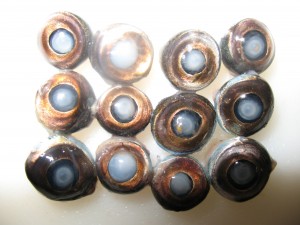Carbon dioxide levels and cataract formation in Atlantic cod

Cataracts affect numerous species of aquacultured fish and may result in impaired vision or blindness, which may reduce food intake and consequently growth rate. The reduction in growth rate in farmed fish directly affects feed conversion efficiency and reduces production efficiency, which ultimately raises the cost of rearing fish. Product quality is often lowered because fish with cataracts often display dermal hyperpigmentation. Also, since eye condition is often an indicator of product quality, fish with cataracts may be unappealing in whole fish markets as eye condition is an indicator of product quality. Therefore, the downgrading as a result of cataracts lowers the market price and can potentially cause a farmer significant financial losses.
A number of potential causative agents have been suggested including nutritional deficiencies, particularly the amino acid histidine, osmotic imbalances, fluctuations in water temperatures, parasitic infestations of the eye, chemical exposure , ultraviolet radiation, oxidative stress to lens fibers, and genetic predisposition.
Experience rearing juvenile Atlantic cod (Gadus morhua) suggests that high percentages of fish are affected by cataracts when kept at high densities in recirculating systems. In 2004, over 98% of juvenile Atlantic cod had cataracts when stocked into floating net pens (unpublished data). Since that time, less fish have been affected with each group that goes out to the net pens, but significant numbers (between 10 and 33% of fish) were still being affected. Upon review of husbandry and water quality parameters, it appears that high levels of dissolved carbon dioxide (CO2) could be the cause.
Recently, a number of studies have found that the amino acid, histidine, can prevent cataracts from forming when salmonids undergo smoltification, that is, the transition from freshwater to saltwater. These cataracts are classified as osmotic cataracts, because they form due to changes in osmolarity within the eye, which can affect the protein structure of the lens. Histidine forms important osmolytes, such as N-acetyl-histidine, or NAH and maintain proper osmolarity within the eye.
Therefore, we investigated the effects of elevated carbon dioxide levels and histidine on cataract formation in juvenile Atlantic cod. Three hypotheses were put forth:
1) Dietary histidine deficiency may induce cataract formation in cod juveniles
2) High levels of dissolved CO2 may induce cataract formation in cod juveniles
3) High dietary histidine may ameliorate the effect of high dissolved CO2 concentration in cod juveniles.
We tested three levels of CO2: Low (6.99 mg/L), Mid (12.20 mg/L), and High (19.67 mg/L) and three levels of histidine in the diet: Low (1.7% HIS as protein), Mid (2.3% HIS as protein), and High (2.9% HIS as protein). Each CO2/diet combination was done in triplicate with tanks containing 160 fish each. Monthly, 30 fish were randomly sampled from each tank and measured for length, weight, and assessed for cataracts using a slit lamp biomicroscope.
After five months, fish raised in the High CO2 treatments were 27% smaller than fish raised in the Low CO2 tanks. As a result, feed conversion ratios, condition factor, and growth rates were much lower in the High CO2 treatments compared to the Low CO2 treatments. Fish also experienced more mortality within the High CO2 treatments (93.5%) than fish in the Low CO2 treatments (97.5%). Most interestingly, fish in the High CO2 treatments experienced significantly higher cataract incidence (~100%) compared to only 30% in the Low CO2 treatments. Cataracts were also more severe in the High CO2 tanks (average score of 6) compared to Low CO2 treatments (average score of 1). However, the inclusion of extra histidine in the diet did not prevent cataracts from forming at any of
Throughout the study, we also measured the pH of the blood, aqueous humor of the eye, blood glucose and blood lactate. We found that there to be changes in the pH of the blood and eye as well as blood glucose based on CO2 level, but none based on dietary histidine. No changes in blood lactate were apparent with regard to CO2 or histidine.
We also followed the development of cataracts with the help of histologist Dawna Beane of the University of Maine Animal Health Health Laboratory. By taking samples of eyes of juvenile cod at various stages of cataract severity, we were able to describe the physiological and morphological changes that occur in the lens of the eye as the cataracts develop.
Additionally, we monitored the changes in calcium precipitates in the lens, which helps identify the physiological processes occurring within the lens. Clive Devoy, of the Sawyer Environmental Chemistry Research Laboratory, analyzed samples using inductively coupled plasma atomic emission spectroscopy. Using this method, we found there to be significant increases in calcium as the severity of the cataracts increased which makes it easier to explain the changes that occur within the lens that lead to cataract development.
The outcomes of this project will allow for us to make changes to the husbandry of Atlantic cod that should result in more efficient production. In the nursery, reduced stocking density and increased use of degassers will be necessary. Ultimately, earlier transfer to net pens will be required to eliminate the impacts of cataracts on this species. By alleviating the negative impacts of cataracts, such as increased mortality, decreased growth, and reduced consumer acceptance, it may allow for the state of Maine to increase aquaculture production of this commercially important species while improving fish welfare at the same time.
